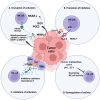CAR NK Cell Therapy for the Treatment of Metastatic Melanoma: Potential & Prospects
- PMID: 38067178
- PMCID: PMC10706172
- DOI: 10.3390/cells12232750
CAR NK Cell Therapy for the Treatment of Metastatic Melanoma: Potential & Prospects
Abstract
Melanoma is among the most lethal forms of cancer, accounting for 80% of deaths despite comprising just 5% of skin cancer cases. Treatment options remain limited due to the genetic and epigenetic mechanisms associated with melanoma heterogeneity that underlie the rapid development of secondary drug resistance. For this reason, the development of novel treatments remains paramount to the improvement of patient outcomes. Although the advent of chimeric antigen receptor-expressing T (CAR-T) cell immunotherapies has led to many clinical successes for hematological malignancies, these treatments are limited in their utility by their immune-induced side effects and a high risk of systemic toxicities. CAR natural killer (CAR-NK) cell immunotherapies are a particularly promising alternative to CAR-T cell immunotherapies, as they offer a more favorable safety profile and have the capacity for fine-tuned cytotoxic activity. In this review, the discussion of the prospects and potential of CAR-NK cell immunotherapies touches upon the clinical contexts of melanoma, the immunobiology of NK cells, the immunosuppressive barriers preventing endogenous immune cells from eliminating tumors, and the structure and design of chimeric antigen receptors, then finishes with a series of proposed design innovations that could improve the efficacy CAR-NK cell immunotherapies in future studies.
Keywords: CAR-NK cell; CAR-NK cell therapy; cancer immunotherapy; melanoma; metastasis; natural killer cell.
Conflict of interest statement
The authors declare no conflict of interest.
Figures




Similar articles
-
Anticancer traits of chimeric antigen receptors (CARs)-Natural Killer (NK) cells as novel approaches for melanoma treatment.BMC Cancer. 2022 Nov 25;22(1):1220. doi: 10.1186/s12885-022-10320-0. BMC Cancer. 2022. PMID: 36434591 Free PMC article.
-
Engineering CAR-NK cells to secrete IL-15 sustains their anti-AML functionality but is associated with systemic toxicities.J Immunother Cancer. 2021 Dec;9(12):e003894. doi: 10.1136/jitc-2021-003894. J Immunother Cancer. 2021. PMID: 34896980 Free PMC article.
-
Advances in CAR-NK cell therapy for hematological malignancies.Front Immunol. 2024 Jun 28;15:1414264. doi: 10.3389/fimmu.2024.1414264. eCollection 2024. Front Immunol. 2024. PMID: 39007146 Free PMC article. Review.
-
Chimeric antigen receptor (CAR) natural killer (NK)-cell therapy: leveraging the power of innate immunity.Br J Haematol. 2021 Apr;193(2):216-230. doi: 10.1111/bjh.17186. Epub 2020 Nov 20. Br J Haematol. 2021. PMID: 33216984 Free PMC article. Review.
-
Preclinical Assessment of Suitable Natural Killer Cell Sources for Chimeric Antigen Receptor Natural Killer-Based "Off-the-Shelf" Acute Myeloid Leukemia Immunotherapies.Hum Gene Ther. 2019 Apr;30(4):381-401. doi: 10.1089/hum.2018.247. Epub 2019 Mar 18. Hum Gene Ther. 2019. PMID: 30734584
Cited by
-
Development of Personalized Strategies for Precisely Battling Malignant Melanoma.Int J Mol Sci. 2024 May 4;25(9):5023. doi: 10.3390/ijms25095023. Int J Mol Sci. 2024. PMID: 38732242 Free PMC article. Review.
-
Pigmented skin lesions with atypical histopathology indicating a diagnosis of multiple metastases of melanoma: A case report.Oncol Lett. 2025 May 27;30(1):369. doi: 10.3892/ol.2025.15115. eCollection 2025 Jul. Oncol Lett. 2025. PMID: 40496544 Free PMC article.
References
-
- Sundararajan S., Thida A.M., Yadlapati S., Koya S. Metastatic Melanoma. StatPearls Publishing; Treasure Island, FL, USA: 2022. - PubMed
-
- National Cancer Institute SEER Cancer Stat Facts: Melanoma of the Skin. National Cancer Institute. [(accessed on 26 December 2022)];National Cancer Institute. 2022 Available online: https://seer.cancer.gov/statfacts/html/melan.html.
Publication types
MeSH terms
Substances
LinkOut - more resources
Full Text Sources
Medical

